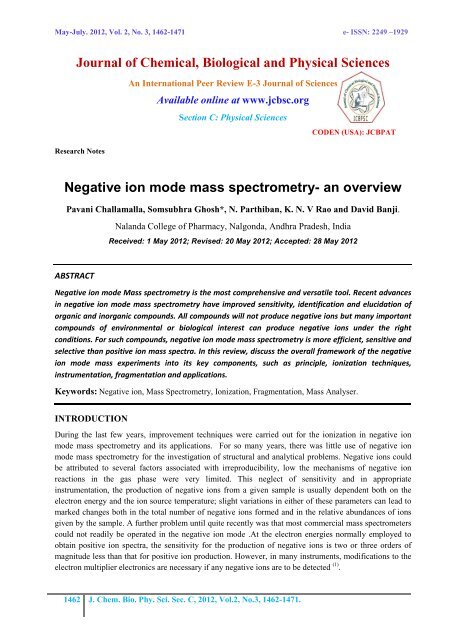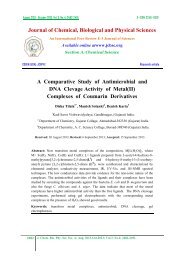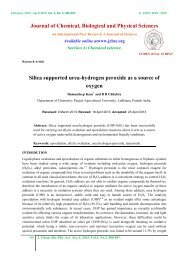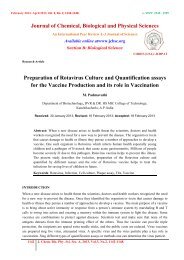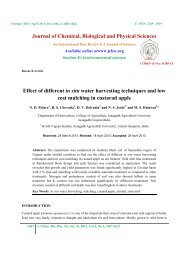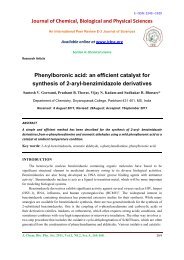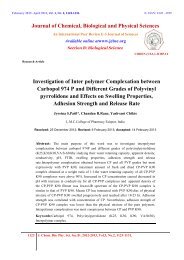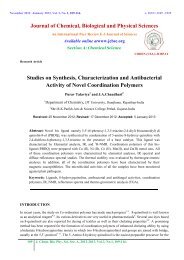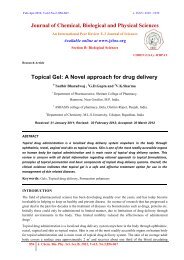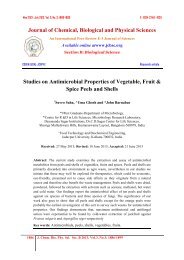Negative ion mode mass spectrometry - Journal of Chemical ...
Negative ion mode mass spectrometry - Journal of Chemical ...
Negative ion mode mass spectrometry - Journal of Chemical ...
You also want an ePaper? Increase the reach of your titles
YUMPU automatically turns print PDFs into web optimized ePapers that Google loves.
<strong>Negative</strong> <strong>ion</strong>...Somsubhra Ghosh et al.The resulting electrical field within the space defined by the four rods are used for resolve <strong>ion</strong>s injectedinto the field. Ions entering this quadrupole electric field undergoing oscillatory trajectories, and at anygiven combinat<strong>ion</strong> <strong>of</strong> applied fields, only one m/z ratio attains a stable trajectory that carries it through theanalyzer;and other <strong>ion</strong>s are collected on the rods. By varying the dc or rf fields, different m/z ratios arebrought to focus.Fig. 5: Shows Schematic diagram <strong>of</strong> Quadrupole <strong>mass</strong> analyzer (13)(b)Time –<strong>of</strong>-flight analyzer: Ion separat<strong>ion</strong> is based on the principle that <strong>ion</strong>s <strong>of</strong> different <strong>mass</strong>es,possessing equal kinetic energy, have different velocities. If there is a fixed distance for the <strong>ion</strong>s to travel,the time <strong>of</strong> travel will vary with their <strong>mass</strong>, the lighter <strong>ion</strong>s travelling faster and reaching the detector in ashorter period <strong>of</strong> time. According to this concept, the kinetic energy <strong>of</strong> an <strong>ion</strong> accelerated through anelectrical potential V will beZv =mv 2 /2 (Equat<strong>ion</strong> 1)and the velocity <strong>of</strong> the <strong>ion</strong> is the length <strong>of</strong> the flight path L divided by the time t. It takes the <strong>ion</strong> to travelover that distance:substituting the equat<strong>ion</strong> 2 in equat<strong>ion</strong> 1Zv=mL 2 /2t 2Thus, it follows thatv=L/t (Equat<strong>ion</strong> 2)m/z=2Vt 2 /L 2(Equat<strong>ion</strong>3)The TOF <strong>mass</strong> analyzer requires very fast electronics to accurately measure <strong>ion</strong> flight times that may besubmicrosecond. Furthermore, the <strong>ion</strong>s in a TOF system must be created in short, well defined pulses sothat the <strong>ion</strong>s all start their journey toward the detector at the same moment.1467 J. Chem. Bio. Phy. Sci. Sec. C, 2012, Vol.2, No.3, 1462-1471.
<strong>Negative</strong> <strong>ion</strong>...Somsubhra Ghosh et al.Fig. 6: Shows Schematic diagram <strong>of</strong> Q-TOF Mass analyzer(c) Ion trap <strong>mass</strong> analyzer: Ion traps are <strong>ion</strong> trapping devices that make use <strong>of</strong> a three-dimens<strong>ion</strong>alquadrupole field to trap and <strong>mass</strong>-analyze <strong>ion</strong>s.It was invented by Wolfgang Paul (Nobel Prize1989) . ItOffers good <strong>mass</strong> resolving power. The <strong>ion</strong> trap consists <strong>of</strong> two hyperbolic end-cap electrodes and adoughnut-shaped ring electrode (by which end cap electrodes are connected). An alternating current (AC)or (DC) and an RF potential is applied between the ring and endcaps electrodes. In the <strong>ion</strong> trap analyzer,<strong>ion</strong>s <strong>of</strong> all m/z values are in the trap simultaneously, oscillating in concentric trajectories. Sweeping theRF potential results in the removal <strong>of</strong> <strong>ion</strong>s with increasing m/z values by putting them unstable trajectorycauses them to be ejected from the trap in the axial direct<strong>ion</strong> toward the detector.Fig. 7:Schematic diagram <strong>of</strong> Ion trap <strong>mass</strong> analyzerFig. 8: Shows Schematic diagram <strong>of</strong> Ion trap <strong>mass</strong> analyzer1468 J. Chem. Bio. Phy. Sci. Sec. C, 2012, Vol.2, No.3, 1462-1471.
<strong>Negative</strong> <strong>ion</strong>...Somsubhra Ghosh et al.(b) It is an accurate method for the determinat<strong>ion</strong> <strong>of</strong> molecular <strong>mass</strong> <strong>of</strong> the components and its elementalcomposit<strong>ion</strong>.(c) It also used to investigate react<strong>ion</strong> mixtures (gases, liquids and solids) and also used in understandingreact<strong>ion</strong> kinetics and mechanisms <strong>of</strong> unimolecular decomposit<strong>ion</strong> react<strong>ion</strong>s (16) .(d) Using solid phase extract<strong>ion</strong> (SPE) and liquid chromatography/tandem <strong>mass</strong> <strong>spectrometry</strong>(LC/MS/MS), 46 pesticides in positive <strong>ion</strong> <strong>mode</strong> and 14 pesticides in negative <strong>ion</strong> <strong>mode</strong> wereanalyzed (17) .(e) Sugar and sugar alcohols such as sorbitol and glucose were successfully analyzed by <strong>mass</strong><strong>spectrometry</strong> using atmospheric pressure <strong>ion</strong>izat<strong>ion</strong> in negative <strong>ion</strong> <strong>mode</strong> (18) .(g) ) ESI in the negative <strong>ion</strong> <strong>mode</strong> has been employed to determine the structure <strong>of</strong> glycosides <strong>of</strong>anthraquinones [67,68], coumarins [67], flavonoids [4,31,67,69,70], iridoids [67,71], aromatics [30,67],cardenolides [29],is<strong>of</strong>lavonoids [57] and triterpenes [67,72] (19) .(h) <strong>Chemical</strong> warfare agents, explosives, dyes are analyzed by using both positive and negative <strong>ion</strong> <strong>mode</strong>by using liquid chromatography-Mass <strong>spectrometry</strong> (20) .(i) By using negative chemical <strong>ion</strong>izat<strong>ion</strong> we can measure the MDA(3,4-Methylene dioxyamphetamine),MDMA(3,4-Methylene dioxy methamphetamine), MDEA(3,4-Methylene dioxy ethyl amphetamine) inblood (21) .CONCLUSIONMass spectrometer is operated in positive and negative <strong>ion</strong> <strong>mode</strong>. Generally now a days positive <strong>ion</strong> <strong>mode</strong>is used in many cases and <strong>Negative</strong> <strong>ion</strong> <strong>mode</strong> spectroscopy is also being used in some specific andsensitive cases, in such cases negative <strong>ion</strong> <strong>mode</strong> is more efficient than the positive <strong>ion</strong> <strong>mode</strong> .In future itcan be used in other fields also.REFERENCES(1) K. R. Jennings, Philosophical Transact<strong>ion</strong>s A., 1979,293:125-133.(2) D. Pavia, Spectroscopy, 2007, page no.401-419.(3) K. S Graham, Applicat<strong>ion</strong>s <strong>of</strong> liquid chromatography: Mass <strong>spectrometry</strong> to cytochromep450 inhibit<strong>ion</strong> screening and the measurement <strong>of</strong> plasma free Metanephrines, University<strong>of</strong> Wales Swansea 2005.(4) J. J. Pitt, Clin Biochem Rev, 2009, 30(1): 19-34.(5) Available at: http://www.colby.edu/chemistry/instruments/ElectrosprayIntro.pdf, Electrospray<strong>ion</strong> <strong>mass</strong> <strong>spectrometry</strong>.(6) D. F Smith, Petroleomics applicat<strong>ion</strong>s <strong>of</strong> fourier transform<strong>ion</strong> cyclotron resonance <strong>mass</strong><strong>spectrometry</strong>:Crude oil and bitumen analysis, The Florida state university college <strong>of</strong> artsand sciences, Oct, 2007.(7) K. A. Schug, Pseudo-molecular <strong>ion</strong> format<strong>ion</strong> by aromatic acids in negative <strong>ion</strong>izat<strong>ion</strong> <strong>mode</strong>electrospray <strong>ion</strong>izat<strong>ion</strong> <strong>mass</strong> <strong>spectrometry</strong>, Oct, 2002.(8) R. Ekman, J. Silberring, A. M.W. Brinkmalm, A. Kraj, D. M. Desiderio, N. M. Nibbering,1470 J. Chem. Bio. Phy. Sci. Sec. C, 2012, Vol.2, No.3, 1462-1471.
<strong>Negative</strong> <strong>ion</strong>...Somsubhra Ghosh et al.Mass <strong>spectrometry</strong>: Instrumentat<strong>ion</strong>,interpretat<strong>ion</strong> and applicat<strong>ion</strong>s, (WileyInterscience, NewYork) 2008.(9) M. Dashtiev, E. W¨afler, U. R¨ohling, M. Gorshkov, F. Hillenkamp, R. Zenobi.,Internat<strong>ion</strong>al <strong>Journal</strong> <strong>of</strong> Mass Spectrometry, 2007, 268:122-130.(10) Available at: http://www.freepatentsonline.com/5204530.html, Noise reduct<strong>ion</strong> in negative<strong>ion</strong>quadrupole <strong>mass</strong> <strong>spectrometry</strong>, April 20, 1993.(11) Y. R. Sharma, Elementary Organic Spectroscopy; Principles And <strong>Chemical</strong> Applicat<strong>ion</strong>s, S.Chand & Company Ltd, 2007, 279-290.(12) D. Wishart, Mass <strong>spectrometry</strong>: Methods & theory.(13) K. A. Connors, A text book <strong>of</strong> Pharmaceutical Analysis, Wiley- India, New Delhi, 2007, 306-307.(14) Available at: http://www.whoi.edu/cms/files/wjenkins/2005/9/Notes07_5343.pdf, Principles<strong>of</strong> <strong>mass</strong> <strong>spectrometry</strong>, AMS, and <strong>ion</strong> optics.(15) M. Fabrizi, C. Pagura, A. Tolstogouzov, S. Daolio, M. Ferretti, E. Magnone and G. L.Olcese, Rapid Commun. Mass Spectrom; 1998,12, 675–682.(16) G. D. Rao, A text book <strong>of</strong> pharmaceutical analysis, volume -2,30 th july, 2002, pageno.140 - 146.(17) Chin-Kai Meng , Determinat<strong>ion</strong> <strong>of</strong> pesticides in water by SPE and LC/MS/MS in bothpositive and negative <strong>ion</strong> <strong>mode</strong>s,September ,2008.(18) H. Kumaguai, Applicat<strong>ion</strong> <strong>of</strong> Liquid Chromatography/Mass Spectrometry to the Analysis <strong>of</strong>Sugars and Sugar-Alcohol, 2001.(19) M. Kubota, K. Yoshida, A. Tawada, M. Ohashi, J. Mass Spectrom. Soc. Jpn., 2002, 50 (2),58-66.(20) G. M. Cabrera, Phytochemistry: Advances in Research, 2006,1-22.(21) ) F. T. Peters, N. Samyn, C.T. Lamers, W.J. Riedel, T. Kraemer, G.D. Boeck, H.H. Maurer,Clinical Chemistry, 2005, 51(10), 1811-1822.*Correspondence Author: Somsubhra GhoshNalanda College <strong>of</strong> Pharmacy, Nalgonda, Andhra Pradesh, India1471 J. Chem. Bio. Phy. Sci. Sec. C, 2012, Vol.2, No.3, 1462-1471.


